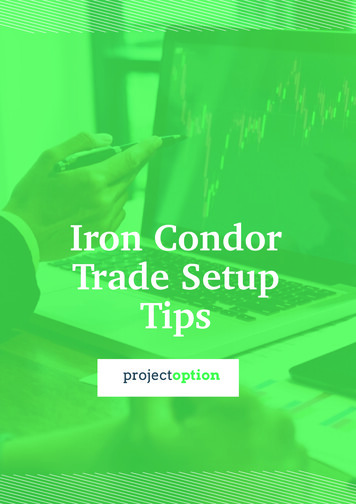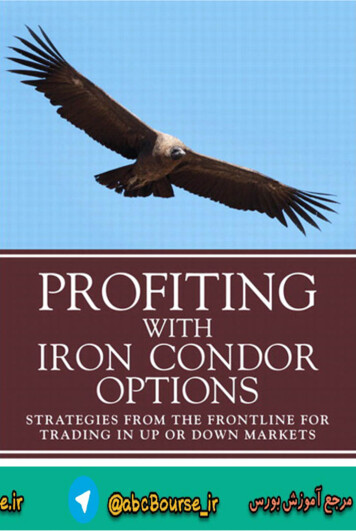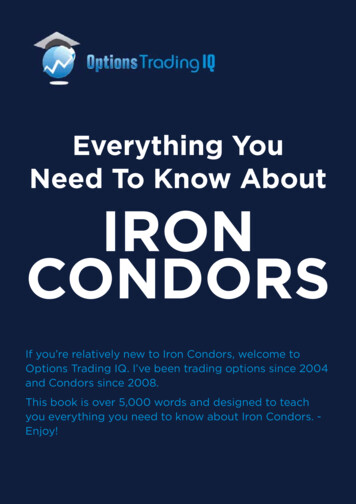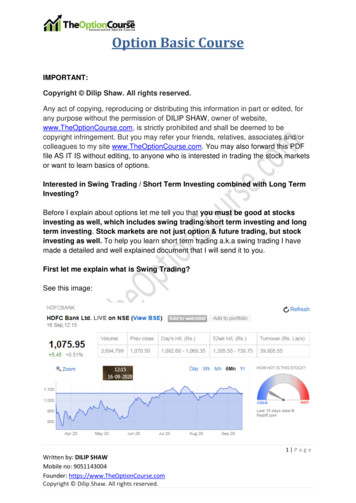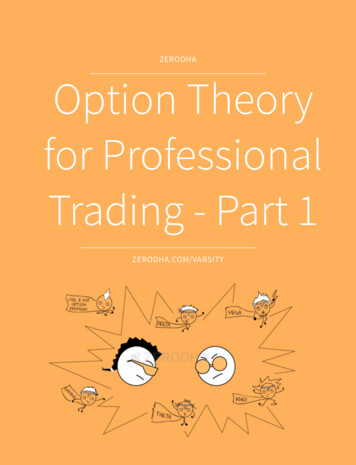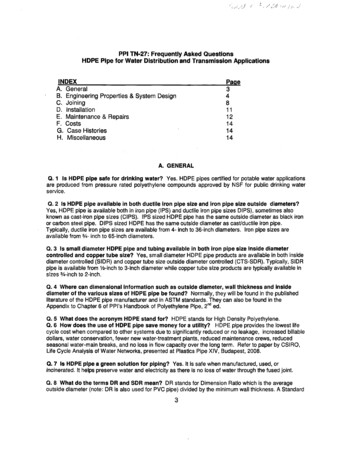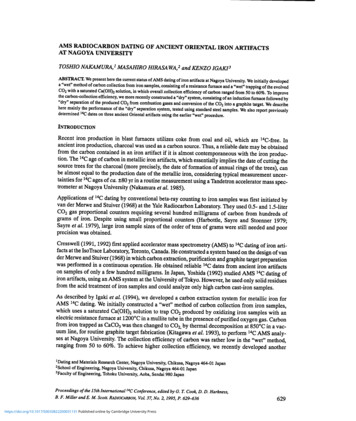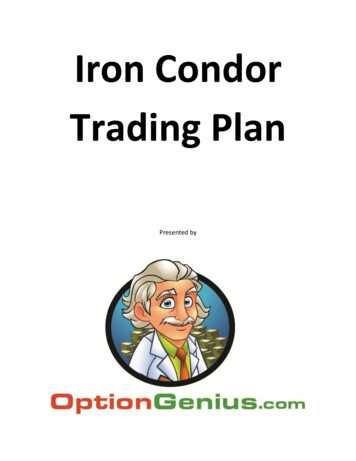
Transcription
Iron CondorTrading PlanPresented by
Copyright Option Genius LLC.All Rights Reserved. No duplication of transmission of the material included within except with express written permission fromthe author.Be advised that all information is issued solely for informational purposes and is not to be construed as an offer to sell or thesolicitation of an offer to buy, nor it is it to be construed as a recommendation to buy, hold, or sell any security, stock, oroption. The principals of and those who provide services for Option Genius LLC: Are neither Registered Investment Advisors nor are Broker/Dealers and are not acting in any way to influence thepurchase of any security.Are not liable for any losses or damages, monetary or otherwise that may result from your reliance on the content ofany written materials or any discussion.May own, buy, or sell securities provided in written materials or discussedHave not promised that you will earn a profit when or if you purchase/Sell stocks, bonds, or options.You are urged to consult with your own independent financial advisor and/or broker before making an investment or tradingsecurities. Past performance may not be indicative of future performance. Securities discussed within are speculative with ahigh degree of volatility and risk. Opinions, analyses and information conveyed whether our own or based on sources believedto be reliable have been communicated in good faith, but no representation or warranty of any kind, expressed or implied ismade including but not limited to any representation or warranty concerning accuracy, completeness, correctness, timelinessor appropriateness. We do not necessarily update such opinions, analysis, or information. All information should beindependently verified.Option trading involves substantial risk and is not suitable for all investors. We cannot and will not guarantee that you will notlose money or that you will make money from the information found on this website and / or affiliated products / services. Pastresults do not guarantee future results. You can lose money trading options and the loss can be substantial. Losing trades canoccur, have occurred in the past, and will occur in the future. Don't trade with money you can't afford to lose. Only risk capitalshould be invested since it is possible to lose all of your principal. Your use of this website and affiliated products / services is atyour own risk. You should read "Characteristics and Risks of Standardized Options" to further understand the risks of tradingoptions.U.S. Government Required Disclaimer - Commodity Futures Trading Commission. Forex, Futures and Options trading has largepotential rewards, but also large potential risk. You must be aware of the risks and be willing to accept them in order to investin the futures and options markets. Don't trade with money you can't afford to lose. This website is neither a solicitation nor anoffer to Buy/Sell futures or options. No representation is being made that any account will or is likely to achieve profits or lossessimilar to those discussed on this website. The past performance of any trading system or methodology is not necessarilyindicative of future results.HYPOTHETICAL PERFORMANCE RESULTS HAVE MANY INHERENT LIMITATIONS, SOME OF WHICH ARE DESCRIBED BELOW. NOREPRESENTATION IS BEING MADE THAT ANY ACCOUNT WILL OR IS LIKELY TO ACHIEVE PROFITS OR LOSSES SIMILAR TO THOSESHOWN. IN FACT, THERE ARE FREQUENTLY SHARP DIFFERENCES BETWEEN HYPOTHETICAL PERFORMANCE RESULTS AND THEACTUAL RESULTS SUBSEQUENTLY ACHIEVED BY ANY PARTICULAR TRADING PROGRAM ONE OF THE LIMITATIONS OFHYPOTHETICAL PERFORMANCE RESULTS IS THAT THEY ARE GENERALLY PREPARED WITH THE BENEFIT OF HINDSIGHT. INADDITION, HYPOTHETICAL TRADING DOES NOT INVOLVE FINANCIAL RISK, AND NO HYPOTHETICAL TRADING RECORD CANCOMPLETELY ACCOUNT FOR THE IMPACT OF FINANCIAL RISK IN ACTUAL TRADING. FOR EXAMPLE, THE ABILITY TO WITHSTANDLOSSES OR ADHERE TO A PARTICULAR TRADING PROGRAM IN SPITE OF TRADING LOSSES ARE MATERIAL POINTS WHICH CANALSO ADVERSELY AFFECT ACTUAL TRADING RESULTS. THERE ARE NUMEROUS OTHER FACTORS RELATED TO THE MARKETS INGENERAL OR TO THE IMPLEMENTATION OF ANY SPECIFIC TRADING PROGRAM WHICH CANNOT BE FULLY ACCOUNTED FOR INTHE PREPARATION OF HYPOTHETICAL PERFORMANCE RESULTS AND ALL OF WHICH CAN ADVERSELY AFFECT ACTUAL TRADINGRESULTS.For more information on Iron Condors and how to trade them visit:OptionGenius.com
Introduction: This report will gives you the basics of what an iron condor is, how it works, thepros and cons of the strategy, and how to trade it.It will also give you a specific trading plan to trade conservative iron condors.The basics come first, then the trading plan. I urge you to read the basics first to get a firmunderstanding of how I think about the condor. This will give you a better understanding ofhow and why I developed the trading plan.The Iron CondorThe iron condor is an option trading strategy that uses two credit spreads.The strategy is simple: Sell credit spreads out of the money: both puts and calls thus creating a“box”. As long as the underlying, stock, etf, or index stays within this box, the trade makesmoney. Since you are selling options the trade results in a credit, and this credit is themaximum amount you can make on your iron condor trade.When you place an iron condor trade, you will be selling the condor. In most circles this isconsidered a short iron condor. I myself do not know too many traders that trade long ironcondors, mainly because in a long iron condor you want the stock to move a lot and if you feel astock is going to make a large move, there are other option strategies that can make you moremoney. So I will focus on the short iron condor.When you trade an iron condor, you want the underlying not to move very much. The biggestthreat of the iron condor is a large move in one direction, especially if it is early in the trade.The condor is a slow trade, meaning that it takes time for the options to decay and lose value.The iron condor is also considered a very conservative trade because you can set it up to have avery high probability of profit. The iron condors I trade are in the 75-80% probability of profitrange. And since the underlyings that I choose do not move much, I do not need to spend muchtime monitoring my position.Let’s look at an iron condor example. Let’s say I trade a condor spread on IBM. If IBM stock isselling at 100, I might short the following iron condor:Sell the 115 Calls, Buy the 120 Calls.Sell the 85 Puts, Buy the 80 Puts.For more information on Iron Condors and how to trade them visit:OptionGenius.com
This trade creates a box that puts my expiration breakeven points at roughly 85 and 115. Aslong as IBM stays within those prices, my iron condor example will make money.If I have this trade on, I can check IBM’s price movement 1-3 times a day. As long as it is notnear an adjustment point, I don’t have to do anything.The Lazy Man’s TradePut it on, watch it once or twice during the day, and that’s it. Entering the trade takes less thanten minutes when you know what you are doing, adjusting it takes just as long if you have atrading plan, and exiting the trade can be as easy as doing nothing and letting the optionsexpire worthless or exiting the trade (which is the same as entering but easier).The Benefits of the Iron Condor1. High Probability of Profit2. High monthly return on investment: 8-15% a month3. You can do the same trade month after month on the same underlying. You do not need to“wait for a set-up”.4. Easily adjusted so you can save your trade if it goes against you.5. Takes very little of your time.6. Can be done anywhere in the world with access to the internet.The Negatives of the Iron Condor1. Since the reward is high, the risk can also be high. An iron condor trader can risk 9 to make 1. He will win most months. But even one loss of 9 will wipe out several months of gains.2. The trade takes time and patience. A trader has to wait for the options to lose value.3. The iron condor is not the best trade in very volatile markets.For more information on Iron Condors and how to trade them visit:OptionGenius.com
Iron Condor PhilosophyStocks move up and they move down. Very rarely do they move in only one direction for anextended period of time. Since most of the time, stocks trade in a range, why don’t we makemoney from the range, instead of trying to determine if they are going up or down?That in essence is the philosophy of the iron condor spread. No need to determine which waythe market will move, because within a 30-50 day time period chances are that the market willstay in a range. Over time, it may move in one direction. But in a short period of time itprobably won’t.So let’s sell options that are far out of the money, which have very little probability of hurtingus, and make money by selling time. As days go by, the options lose value, the markets go upand down, and we profit.Iron condor spread trading is non-directional trading. An iron condor trader does not need toknow which way the market is going. It helps if he does know, but my opinion is that no one canaccurately predict over and over which way the market is going or where it will go to.So when people ask me what I think of the market, I tell them “I don’t know”. And as an ironcondor spread trader I don’t really need to know. As long as it gets to wherever it is goingslowly, my iron condor spread trades will make money.Two Types of Condor TradersThere are two major schools of thought when it comes to the Iron Condor spread. The firstschool says that the condor spread trade is a strategy that works on its own. In other words, noadjustments are needed. If you let it do its thing, over time the trade will make money.The other school of thought says that you should adjust your condor spread trades when theyget into trouble.I fall into the second school. I don’t like losing money and taking a max loss on a condor tradeby not adjusting it can be a depressing event.By adjusting a condor, I mean to make changes to the original position to impact the trade.There are many different adjustments possible, and I will cover them later in this mini-course.By adjusting the trade, you give yourself an even better chance to make money. But every timeyou do an adjustment, you reduce the maximum yield you can make on the trade.What Probability Do You Want?For more information on Iron Condors and how to trade them visit:OptionGenius.com
Once an iron condor trader has decided if he will adjust or not, he must decide what probabilityof profit he wants to aim for. Does he want 60%, 70%, 80% or more? Based on this number hewill pick his strikes (options to sell). The further away from the money, the greater the chancethat the iron condor spread will make money, but the lower the yield and the greater the maxloss.I like to be in the 80% probability range.Another way to influence the probability is the amount of time to be in the trade. A trader canbe far from the money, with a high probability of profit, and a higher than normal yield, butonly if he stays in the trade longer.For example, an iron condor that is entered 50 days to expiration has more yield and optionpremium than one entered 25 days to expiration. But those extra 25 days add risk thatsomething could happen in the market to hurt the position during that time.How to Determine StrikesWhen it comes to strikes, again we have two schools of thought.One group of traders uses technical analysis to determine which strikes to sell. They look at thecharts, find the support and resistance levels and whatever other technical indicators they useand sell strikes that they feel give them the best chance of making money.The other group, of which I belong, use statistics and math to determine which strikes to sell.By using statistics you can set your strikes to have a high degree of confidence that your strikeswill be safe. For example, you can set your strikes one standard deviation away from themoney, or two standard deviations away. These deviations are calculated, using option prices,the volatility of the underlying, the time left to expiration, and several other factors.Whichever of these two methods you use, keep in mind that there is no guarantee that themarket will not violate your short options. So even with a high probability of profit, you can stilllose money.Risk ManagementSo far we have talked about how the iron condor has great probability of success and cangenerate a decent return month after month.In this section we are going to talk about what happens when things go wrong.For more information on Iron Condors and how to trade them visit:OptionGenius.com
Most traders say that iron condor options trading is a conservative strategy. Others say it is veryrisky because you can lose a lot more than you can make.It all depends on how you set up the condor spread. You can choose strikes that are way out ofthe money and that give you a 95% probability of success or you can choose strikes that areclose to the money and give you a 40% chance of success.The closer your short strikes are to the money, the more your iron condor becomes a butterfly.A butterfly is also two credit spreads like a condor but close to the money.As an example, let’s look at a condor spread that has an 80% probability of success. In ourexample we get a credit of 1.00 and the max we can lose is 9.0. So we can make 100 perspread or lose 900. As you can see you don’t have to lose too many times to lose all yourmoney. Even if you win 9 times and lose once, you will be negative. And since the odds aresaying you will win 8 times and 2 two times for every ten trades this is a losing proposition.But no one said you have to lose the whole amount.By using money management you can limit your losses in the months your condor spread is notgoing to make money. And yes, there are months where no matter your adjustments, you arestill going to lose unless you are willing to throw an endless supply and money at it and arewilling to roll into other months.Instead of letting our condor spreads go all the way to the max loss; let’s say we decide to limitour loss to 20%. For simplicity sake we will limit our loss in the example to 2. Once we enterthe trade, we get 1. But if we are ever down 2 or 200 per spread then we exit the trade.What about Stop Loss Orders?You can use them. Place orders to buy back your spreads at whatever you decide as anacceptable max loss. That should help you sleep at night.What about another 9/11 event?The iron condor does well when the markets are flat. Or if they go in one direction then it worksif the move is a slow on. A major event like a 9/11 event that makes the market move huge inone day can kill an iron condor trader.Normally, these types of moves happen to the downside. If there is a nuclear explosion, or war,or earthquake, or anything similar, the markets will drop. As is the common phrase “Bulls go upFor more information on Iron Condors and how to trade them visit:OptionGenius.com
the stairs. Bears go out the window.”An iron condor trader can protect herself from such an event by buying Put insurance. Yousimply take some of the credit you get and buy enough put protection to protect yourself incase the word ends. With this insurance, if the markets go down enough you can still makemoney even if you lose the max on the condor spread.To mitigate the risk of getting to the max loss, you simply decide on an exit point. “When I amdown % or I will exit the trade and live to trade another day.”And to protect yourself from the end of the world, simply buy some Put(s) as insurance. Howmany puts and which puts is a matter of personal preference and depends on your trade size.Creating Your Own Trading PlanThere are as many iron condor trading strategies as there are iron condor traders. Everyone hastheir own preferences and style.To create your own iron condor strategy you have to first choose the underlying. You don’treally need an iron condor screener or software program to find suitable candidates for you.Stick to Indexes and ETFs at first. As you become more experienced you can move into stocks.Indexes and ETFs have the benefit of being composed of several companies and so the news,good or bad, of any one company will not affect the price as much. Pick one that you feel isrelatively stable. Some good candidates are: SPX, SPY, RUT, IWM, DIA, QQQQ, NDX, MNX, XLE,XLF, and RTH.Step two in creating your own iron condor strategy is to decide how far out from the moneyyou want to go. The farther out, the greater the probability of profit but the lower the return.You have to offset this by going out farther from expiration.So let’s say you are looking to sell an iron condor on SPY that has an 80% probability of success.If you sell it at 60 days from expiration your max gain can be 18%, but if you sell it 30 days fromexpiration you can get only 11%. Which do you go for? With experience you will be able todetermine which is the best time to get into a condor that is best suited to your risk toleranceand trading style.Step three in creating your iron condor trading strategy is creating your trading plan.How many spreads will you trade?How much money will you put at risk?For more information on Iron Condors and how to trade them visit:OptionGenius.com
Will you get into both the puts and call at one time, or will you leg in?Will you use all your capital or keep some in reserve for adjustments?Will you adjust or not?Will you enter all the spreads at one time, or will you enter some today and more a few dayslater to try to diversify the trade?What will be the max loss you are willing to accept?Will you take the trade off for a profit before expiration?If yes, then when, and under what circumstances?As you can see there are a lot of things to think about when trading iron condors. The betteryour trading plan, the less you have to worry about when you are in a trade that goes bad.AdjustmentsAdjustments are what separate the men from the boys.Some traders and advisories say that you do not need adjustment. That they only lower yourreturn and increase your commissions. That without adjustments your trades should work outdue to the probabilities.That has not been my experience. I have backtested several no adjustment iron condorstrategies and have not found one that worked on a consistent basis without very largedrawdowns in equity.So why would an advisory not like adjustments?I think it is because it makes it much harder to keep subscribers. The easier the trade, the morepeople will stick around with the service.Even with my service when a trade gets hairy and there are several adjustments, members loseconfidence and drop out.But I still have to trade the way I know how. If some people drop out, there is nothing I can doabout it.The iron condor trade will need an adjustment about 50% of the time if you are a conservativetrader. When to adjust and how to adjust are difficult concepts that can take several trades tomaster. When it comes to iron condor trading, experience really is the key to success.You should know when you will adjust before you enter the iron condor trade.For more information on Iron Condors and how to trade them visit:OptionGenius.com
1. One common method of choosing an adjustment point is by watching the deltas of yourshort strikes. For example, one trader I know enters a condor spread position 27 days fromexpiration using short strikes that have a 18 delta (or as close to it as he can find). He then willadjust his position when his short strike is one or two strikes away from the money.So if he was trading the RUT, and his short call strike was 600, he would adjust his call spreadwhen the RUT got to 590. And he would adjust by using a butterfly to roll his call spread up onestrike.If he is trading one spread, he would be short 1 600 call and long 1 610 call. To adjust he wouldBuy 1 600 call, Sell 2 610 calls, and Buy 1 620 call. The result of this adjustment is that he is nowshort 1 610 call and long 1 620 call.2. Keeping It Delta NeutralAnother method of adjusting the iron condor trade is to keep the position delta neutral. Thedelta of the trade tells you much you will make or lose should the underlying move up or down1 point. If your trade has a delta of 50, you will make 50 if the underlying goes up 1 point.Thus, the lower your delta the less you make or lose when the underlying moves.If you keep your trade as delta neutral you are looking to stay in the trade until the time decaykicks in.Staying delta neutral sounds great, but it is very hard to do since delta is always changing. Aposition of delta – 100 one day can be a position of positive 40 delta the next if you decide togo this route, you will be adjusting often and your commission costs will be much higher.3. A very popular method of adjusting is called rolling. If one side of your trade gets intotrouble, you simply buy back that spread and sell another one farther away from the money. Ifthere is not enough time left in the trade, or the premium of the farther away options is nothigh enough you can even roll forward to the next month.4. Buying puts and calls can also be a good adjustment.By buying options, you will bring your delta closer to zero and even out your current p&l line.Long options act as a buffer to the market moving in one direction against you.5. Another method that some bold traders use is to buy back the short option in a credit spreadand keep the long option hoping that the underlying keeps moving in the same direction.For more information on Iron Condors and how to trade them visit:OptionGenius.com
So if the RUT is moving down rapidly, you can buy back the Put you sold, and keep the one youbought. If RUT keeps dropping, your long Put can make a lot of money.Trading RulesOk, so now you know the basics.Here is a trading plan you can use. A friend of mine developed this and it has been working verywell for him. I use it as well.Underlying to trade: RUTTrade Entrance: Put this trade on 50 days before expiration. It’s best to only have one trade on atone time. If you are still trading the previous month, wait until you are out of that trade to put onthe next month (even if this means you put on the next month at less than 50 days).Strikes: Sell the delta 10 strike or first strike under 10 delta on both sides.Minimum credit: for each side/spread: .50 (.50 for Calls, .50 for Puts)Target Profit: 60% of the total creditMax Loss: Twice the Target Profit which is 1.2 times the total credit.Adjustments: Adjust when either side gets to .20 delta. Take off entire trade (both sides) Wait untilthe next day. Reenter on a day when the underlying moves less than one standard deviation even ifyou have to wait a couple days. Choose new short strikes at delta 10.Re-enter the entire condor with one and a half times the contracts you had in the original position.(See below for alternate strike positioning.) DO NOT wait significantly beyond delta .20 to adjust.If underlying has moved more than 1 Standard Deviation or more on your adjustment day, waitto re-enter as above. You don’t want to reenter on a day in which RUT is moving more than 1Standard Deviation. If you have to wait more than 3 days for movement less than 1 StandardDeviation, then don’t re‐enter the trade (the month is over.)Also, don’t make adjustments with less than 14 days to expiration.NOTE: Increase the size of the trade only ONCE. If you hit delta .20 a second time, you can eitherreposition the condor without increasing the size and reset your profit target at a lower level, or ifyou have hit the max loss, exit the trade.If either spread (put or call spread) is ever worth .20 cents or less, take it off, and reposition itimmediately back to the first strike less than .10 delta, but cut the size of that side in half (i.e, ifFor more information on Iron Condors and how to trade them visit:OptionGenius.com
you had a 10 contract spread that you took off for .20 cents or less, put the new one back on at 5contracts.)If you had previously increased the size by 150% due to hitting .20 delta as above, reset the sizeback to the original number of contracts. Check your analyze graph after each adjustment. If thetotal potential profit has decreased since you put the trade on, lower your profit target to be60% of the new potential credit. Never increase the profit target from the original. Also, neverincrease the max loss target from the original under any circumstances.Alternate strike repositioning: When repositioning the trade after taking it off at .20 delta:a) If you took it off because the short call hit .20 delta (threatened on the upside), start bylooking at the strikes on both sides that are the first ones less than .10 delta, and thenchoose the strikes that are one strike lower on both sides.b) If you took it off because the short put hit .20 delta (threatened on the downside), start bylooking at the strikes on both sides that are the first ones less than .10 delta, and thenchoose the strikes that are one strike higher on both sides.The advantage here is that it doesn’t take the trade back to totally delta neutral and recognizesthe fact that the market is probably “tired”. This works better in whip‐saw markets.For more information on Iron Condors and how to trade them visit:OptionGenius.com
The iron condor is an option trading strategy that uses two credit spreads. The strategy is simple: Sell credit spreads out of the money: both puts and calls thus creating a “box”. As long as the underlying, stock, et
